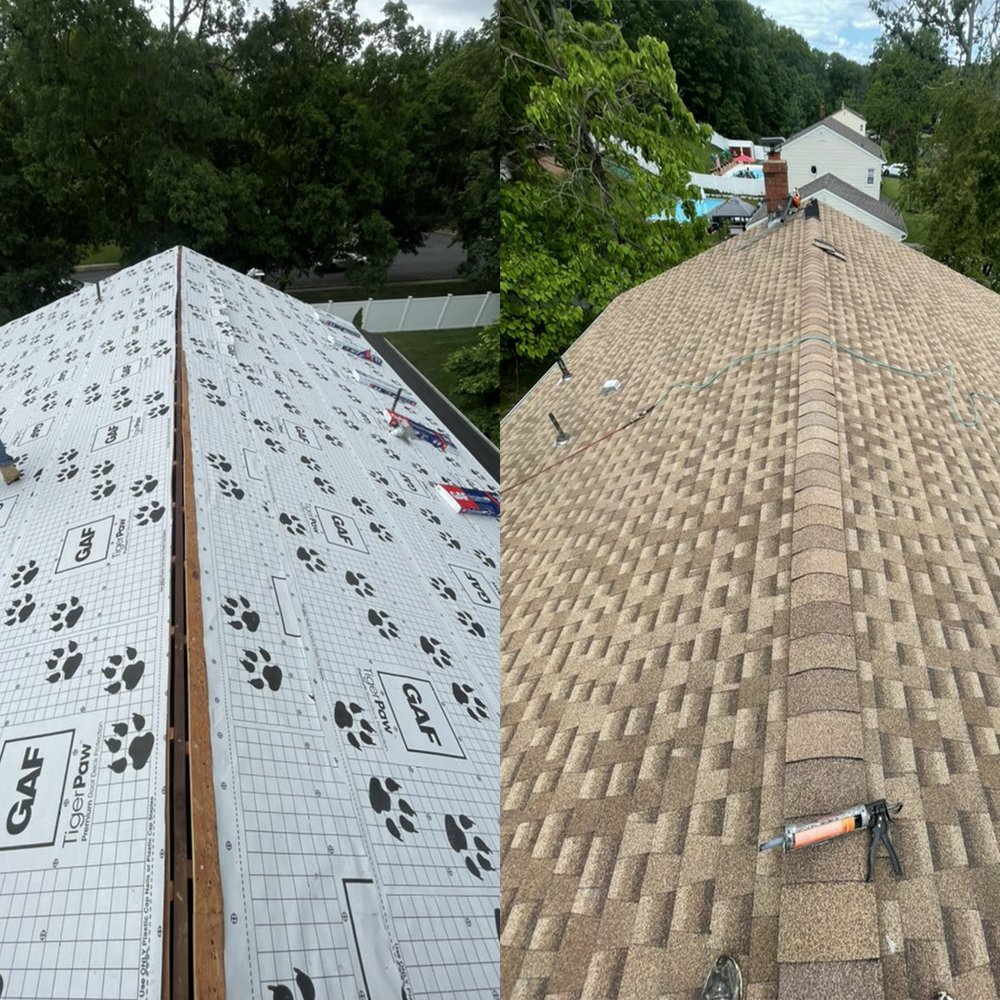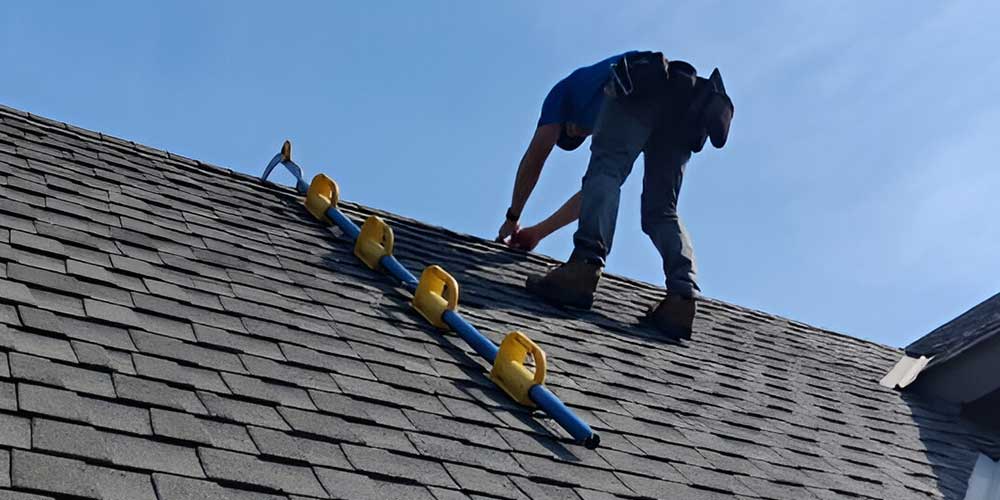Roofers Oahu: Skilled Service Providers for Roof Installations and Fixes
Roofers Oahu: Skilled Service Providers for Roof Installations and Fixes
Blog Article
Understanding the Different Kinds Of Roofings: A Comprehensive Guide for Homeowners
With an array of choices-- ranging from the typical gable to the modern level-- each kind provides unique benefits and obstacles that should straighten with the property owner's certain demands and ecological factors to consider. As we discover the intricacies of various roofing kinds, it comes to be evident that one size does not fit all; the ideal selection might surprise you.
Saddleback Roof
Saddleback roofs, characterized by their triangular shape, are amongst the most preferred roof covering styles because of their simpleness and efficiency in shedding water and snow. This layout includes 2 sloping sides that fulfill at a ridge, enabling reliable drainage and lessening the risk of water build-up. The steep pitch typically linked with saddleback roofs enhances their capability to deal with heavy precipitation, making them suitable for different environments.
In addition to their functional benefits, saddleback roofs offer visual flexibility. They can be adjusted to numerous building designs, from conventional to contemporary homes. The style can additionally fit added attributes such as dormer windows, which boost natural light and air flow in the attic space.
Moreover, saddleback roofs provide adequate space for insulation, adding to power performance. Home owners can pick from a variety of roof covering materials, consisting of asphalt roof shingles, metal, and ceramic tiles, additionally boosting modification choices.
Regardless of their benefits, saddleback roofs might call for additional assistance in areas vulnerable to high winds or heavy snowfall. On the whole, the saddleback roof stays a preferred selection as a result of its blend of performance, resilience, and aesthetic allure.
Flat Roofs
Level roof coverings are frequently recognized for their minimal layout and sensible applications, particularly in commercial and business setups (oahu roofing). These roof coverings feature a straight or almost straight surface, which enables for very easy construction and flexible space usage. While they may do not have the aesthetic allure of angled roofs, level roof coverings offer countless advantages, specifically in urban environments where making best use of area is vital
One of the key advantages of level roofings is their access. Home owners can use the roofing system room for various functions, such as roof gardens, terraces, or solar panel installations. Additionally, level roofing systems are typically extra economical to mount and keep contrasted to their sloped equivalents, as they call for less materials and labor.
Common materials used for flat roofs consist of built-up roofing (BUR), customized asphalt, and single-ply membrane layers, each offering unique benefits. Generally, level roofs offer as a useful and versatile selection for many house owners and companies alike.
Hip Roof Coverings
Hip roof coverings are characterized by their sloped sides that assemble at the top, forming a ridge. This style is unique from gable roof coverings, as all four sides of a hip roof incline downwards towards the wall surfaces, providing a much more secure framework. The angle of the slopes can vary, enabling for adaptability in architectural aesthetic appeals and performance.
Among the primary advantages of hip roof coverings is their capacity to endure heavy winds and damaging climate condition. The sloped surfaces allow far better water drain, lowering the threat of leakages and water damage. Furthermore, hip roofings offer enhanced attic room area, which can be made use of for storage and even exchanged livable locations.
Nevertheless, building a hip roofing system can be extra intricate and expensive than less complex roofing system kinds, such as gable roofing systems. The extra product and labor associated with visit the website producing the slopes and ensuring appropriate important site structural stability can bring about greater expenses. Despite these drawbacks, several homeowners favor hip roofs for their sturdiness, visual allure, and potential for energy effectiveness.
Mansard Roofing Systems
Mansard roofing systems, frequently acknowledged by their special four-sided style, function two inclines on each side, with the reduced slope being steeper than the top. This building design, originating from France in the 17th century, is not only aesthetically enticing however useful, as it takes full advantage of the functional space in the top floorings of a structure. The steep lower slope permits for even more clearance, making it a perfect selection for attics or lofts, which can be exchanged living areas.
Mansard roofs are characterized by their versatility, accommodating various building styles, from conventional to contemporary. They can be built with different products, consisting of asphalt shingles, slate, or steel, offering house owners with a variety of options to fit their budget plans and preferences. Additionally, the layout permits the integration of dormer windows, improving all-natural light and air flow in the upper degrees.
Nevertheless, it is vital to take into consideration the potential drawbacks. Mansard roof coverings might call for even more upkeep as a result of the complexity of their design, and their high inclines can be challenging for snow and rainfall overflow. On the whole, mansard roofs combine beauty with usefulness, making them a popular option amongst homeowners seeking distinct architectural functions.
Shed Roofings
As homeowners increasingly seek simplicity and performance in their architectural designs, lost roof coverings have emerged as a preferred option. Defined by a solitary sloping plane, a shed roof covering provides a minimalist aesthetic that complements different link home designs, from modern to rustic.
Among the key benefits of a shed roof covering is its simple building, which frequently translates to lower labor and material costs. This design enables effective water drain, minimizing the threat of leaks and water damages. In addition, the vertical slope provides sufficient space for skylights, improving all-natural light within the interior.
Shed roof coverings additionally supply adaptability in regards to usage. They can be effectively incorporated into enhancements, garages, or outside frameworks like structures and sheds. In addition, this roofing system style can accommodate numerous roof materials, including metal, asphalt roof shingles, or also green roofings, straightening with eco-friendly campaigns.
However, it is important to think about local environment problems, as heavy snow loads might demand changes to the roof covering's angle or structure. Overall, shed roof coverings provide a useful and aesthetically pleasing option for home owners aiming to make the most of capability without compromising style.
Final Thought


Gable roof coverings, defined by their triangular shape, are among the most preferred roofing styles due to their simplicity and performance in dropping water and snow. oahu roofing. The steep pitch generally connected with gable roofings improves their capacity to deal with heavy rainfall, making them appropriate for different climates
While they may lack the aesthetic charm of pitched roofs, flat roof coverings offer many advantages, specifically in urban environments where taking full advantage of space is essential.

Report this page